Accounting Skills SBS MBA/MSc Assignment - Finance, Qatar 2019
VerifiedAdded on 2022/09/09
|15
|3605
|26
Homework Assignment
AI Summary
This assignment, prepared for an MBA/MSc course in Qatar, delves into fundamental accounting principles. It begins with an exploration of the significance and scope of accounting, including the preparation of an income statement and balance sheet for Potus Corporation. The assignment then examines break-even point analysis, its importance, advantages, and limitations, followed by a practical calculation for Robert Industries. Furthermore, the document covers variance analysis, calculating direct material, labor, and overhead variances for the Walter Group. Finally, it addresses budgeting, outlining key components and considerations for business owners. This comprehensive solution offers detailed explanations and calculations, providing valuable insights into key accounting concepts and their practical applications.
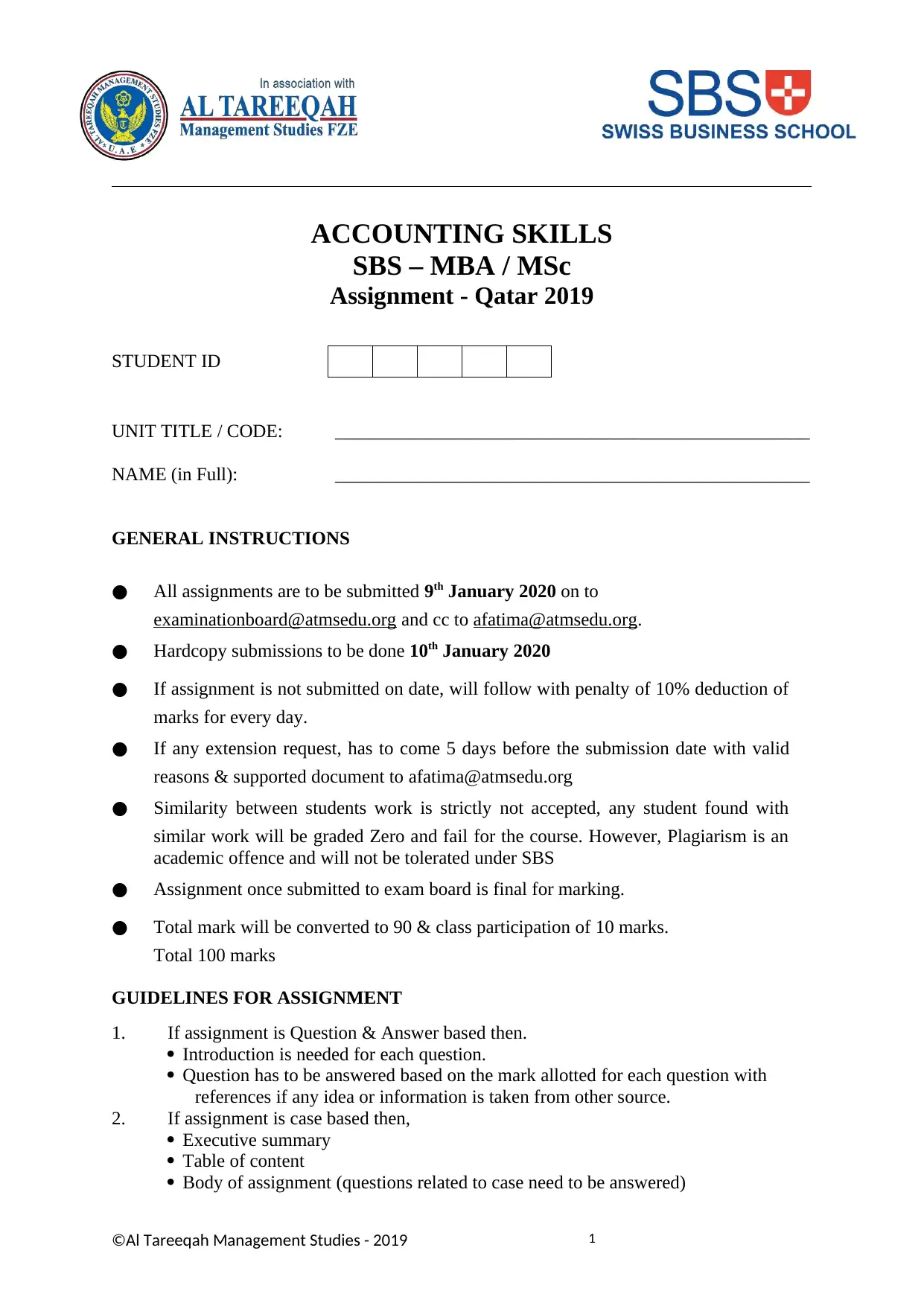
1
ACCOUNTING SKILLS
SBS – MBA / MSc
Assignment - Qatar 2019
STUDENT ID
UNIT TITLE / CODE: ___________________________________________________
NAME (in Full): ___________________________________________________
GENERAL INSTRUCTIONS
● All assignments are to be submitted 9th January 2020 on to
examinationboard@atmsedu.org and cc to afatima@atmsedu.org.
● Hardcopy submissions to be done 10th January 2020
● If assignment is not submitted on date, will follow with penalty of 10% deduction of
marks for every day.
● If any extension request, has to come 5 days before the submission date with valid
reasons & supported document to afatima@atmsedu.org
● Similarity between students work is strictly not accepted, any student found with
similar work will be graded Zero and fail for the course. However, Plagiarism is an
academic offence and will not be tolerated under SBS
● Assignment once submitted to exam board is final for marking.
● Total mark will be converted to 90 & class participation of 10 marks.
Total 100 marks
GUIDELINES FOR ASSIGNMENT
1. If assignment is Question & Answer based then.
Introduction is needed for each question.
Question has to be answered based on the mark allotted for each question with
references if any idea or information is taken from other source.
2. If assignment is case based then,
Executive summary
Table of content
Body of assignment (questions related to case need to be answered)
©Al Tareeqah Management Studies - 2019
ACCOUNTING SKILLS
SBS – MBA / MSc
Assignment - Qatar 2019
STUDENT ID
UNIT TITLE / CODE: ___________________________________________________
NAME (in Full): ___________________________________________________
GENERAL INSTRUCTIONS
● All assignments are to be submitted 9th January 2020 on to
examinationboard@atmsedu.org and cc to afatima@atmsedu.org.
● Hardcopy submissions to be done 10th January 2020
● If assignment is not submitted on date, will follow with penalty of 10% deduction of
marks for every day.
● If any extension request, has to come 5 days before the submission date with valid
reasons & supported document to afatima@atmsedu.org
● Similarity between students work is strictly not accepted, any student found with
similar work will be graded Zero and fail for the course. However, Plagiarism is an
academic offence and will not be tolerated under SBS
● Assignment once submitted to exam board is final for marking.
● Total mark will be converted to 90 & class participation of 10 marks.
Total 100 marks
GUIDELINES FOR ASSIGNMENT
1. If assignment is Question & Answer based then.
Introduction is needed for each question.
Question has to be answered based on the mark allotted for each question with
references if any idea or information is taken from other source.
2. If assignment is case based then,
Executive summary
Table of content
Body of assignment (questions related to case need to be answered)
©Al Tareeqah Management Studies - 2019
Paraphrase This Document
Need a fresh take? Get an instant paraphrase of this document with our AI Paraphraser

2
Conclusion / Recommendation if any
References (in-text + citation) to be used.
©Al Tareeqah Management Studies - 2019
Conclusion / Recommendation if any
References (in-text + citation) to be used.
©Al Tareeqah Management Studies - 2019
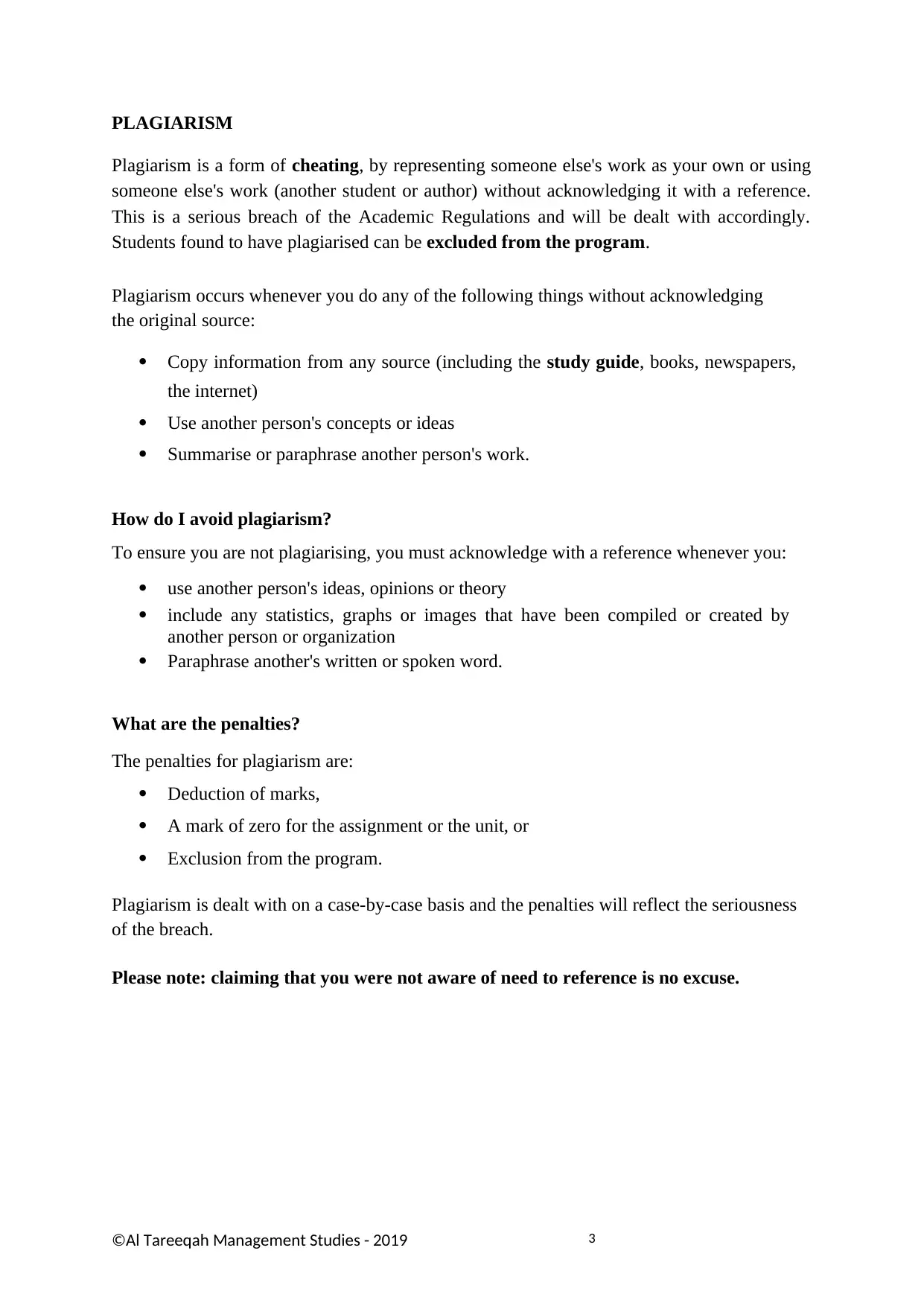
3
PLAGIARISM
Plagiarism is a form of cheating, by representing someone else's work as your own or using
someone else's work (another student or author) without acknowledging it with a reference.
This is a serious breach of the Academic Regulations and will be dealt with accordingly.
Students found to have plagiarised can be excluded from the program.
Plagiarism occurs whenever you do any of the following things without acknowledging
the original source:
Copy information from any source (including the study guide, books, newspapers,
the internet)
Use another person's concepts or ideas
Summarise or paraphrase another person's work.
How do I avoid plagiarism?
To ensure you are not plagiarising, you must acknowledge with a reference whenever you:
use another person's ideas, opinions or theory
include any statistics, graphs or images that have been compiled or created by
another person or organization
Paraphrase another's written or spoken word.
What are the penalties?
The penalties for plagiarism are:
Deduction of marks,
A mark of zero for the assignment or the unit, or
Exclusion from the program.
Plagiarism is dealt with on a case-by-case basis and the penalties will reflect the seriousness
of the breach.
Please note: claiming that you were not aware of need to reference is no excuse.
©Al Tareeqah Management Studies - 2019
PLAGIARISM
Plagiarism is a form of cheating, by representing someone else's work as your own or using
someone else's work (another student or author) without acknowledging it with a reference.
This is a serious breach of the Academic Regulations and will be dealt with accordingly.
Students found to have plagiarised can be excluded from the program.
Plagiarism occurs whenever you do any of the following things without acknowledging
the original source:
Copy information from any source (including the study guide, books, newspapers,
the internet)
Use another person's concepts or ideas
Summarise or paraphrase another person's work.
How do I avoid plagiarism?
To ensure you are not plagiarising, you must acknowledge with a reference whenever you:
use another person's ideas, opinions or theory
include any statistics, graphs or images that have been compiled or created by
another person or organization
Paraphrase another's written or spoken word.
What are the penalties?
The penalties for plagiarism are:
Deduction of marks,
A mark of zero for the assignment or the unit, or
Exclusion from the program.
Plagiarism is dealt with on a case-by-case basis and the penalties will reflect the seriousness
of the breach.
Please note: claiming that you were not aware of need to reference is no excuse.
©Al Tareeqah Management Studies - 2019
⊘ This is a preview!⊘
Do you want full access?
Subscribe today to unlock all pages.

Trusted by 1+ million students worldwide
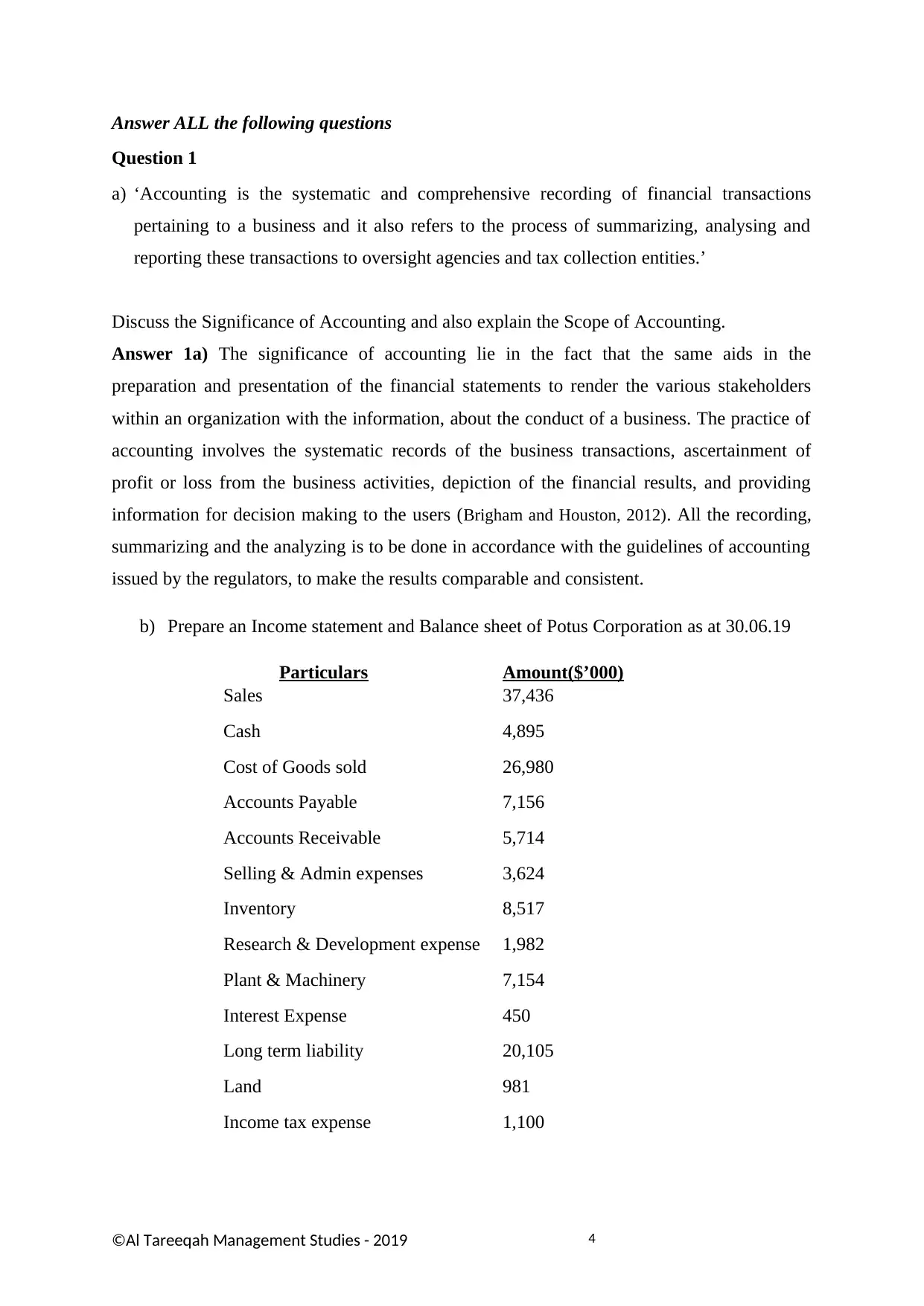
4
Answer ALL the following questions
Question 1
a) ‘Accounting is the systematic and comprehensive recording of financial transactions
pertaining to a business and it also refers to the process of summarizing, analysing and
reporting these transactions to oversight agencies and tax collection entities.’
Discuss the Significance of Accounting and also explain the Scope of Accounting.
Answer 1a) The significance of accounting lie in the fact that the same aids in the
preparation and presentation of the financial statements to render the various stakeholders
within an organization with the information, about the conduct of a business. The practice of
accounting involves the systematic records of the business transactions, ascertainment of
profit or loss from the business activities, depiction of the financial results, and providing
information for decision making to the users (Brigham and Houston, 2012). All the recording,
summarizing and the analyzing is to be done in accordance with the guidelines of accounting
issued by the regulators, to make the results comparable and consistent.
b) Prepare an Income statement and Balance sheet of Potus Corporation as at 30.06.19
Particulars Amount($’000)
Sales 37,436
Cash 4,895
Cost of Goods sold 26,980
Accounts Payable 7,156
Accounts Receivable 5,714
Selling & Admin expenses 3,624
Inventory 8,517
Research & Development expense 1,982
Plant & Machinery 7,154
Interest Expense 450
Long term liability 20,105
Land 981
Income tax expense 1,100
©Al Tareeqah Management Studies - 2019
Answer ALL the following questions
Question 1
a) ‘Accounting is the systematic and comprehensive recording of financial transactions
pertaining to a business and it also refers to the process of summarizing, analysing and
reporting these transactions to oversight agencies and tax collection entities.’
Discuss the Significance of Accounting and also explain the Scope of Accounting.
Answer 1a) The significance of accounting lie in the fact that the same aids in the
preparation and presentation of the financial statements to render the various stakeholders
within an organization with the information, about the conduct of a business. The practice of
accounting involves the systematic records of the business transactions, ascertainment of
profit or loss from the business activities, depiction of the financial results, and providing
information for decision making to the users (Brigham and Houston, 2012). All the recording,
summarizing and the analyzing is to be done in accordance with the guidelines of accounting
issued by the regulators, to make the results comparable and consistent.
b) Prepare an Income statement and Balance sheet of Potus Corporation as at 30.06.19
Particulars Amount($’000)
Sales 37,436
Cash 4,895
Cost of Goods sold 26,980
Accounts Payable 7,156
Accounts Receivable 5,714
Selling & Admin expenses 3,624
Inventory 8,517
Research & Development expense 1,982
Plant & Machinery 7,154
Interest Expense 450
Long term liability 20,105
Land 981
Income tax expense 1,100
©Al Tareeqah Management Studies - 2019
Paraphrase This Document
Need a fresh take? Get an instant paraphrase of this document with our AI Paraphraser
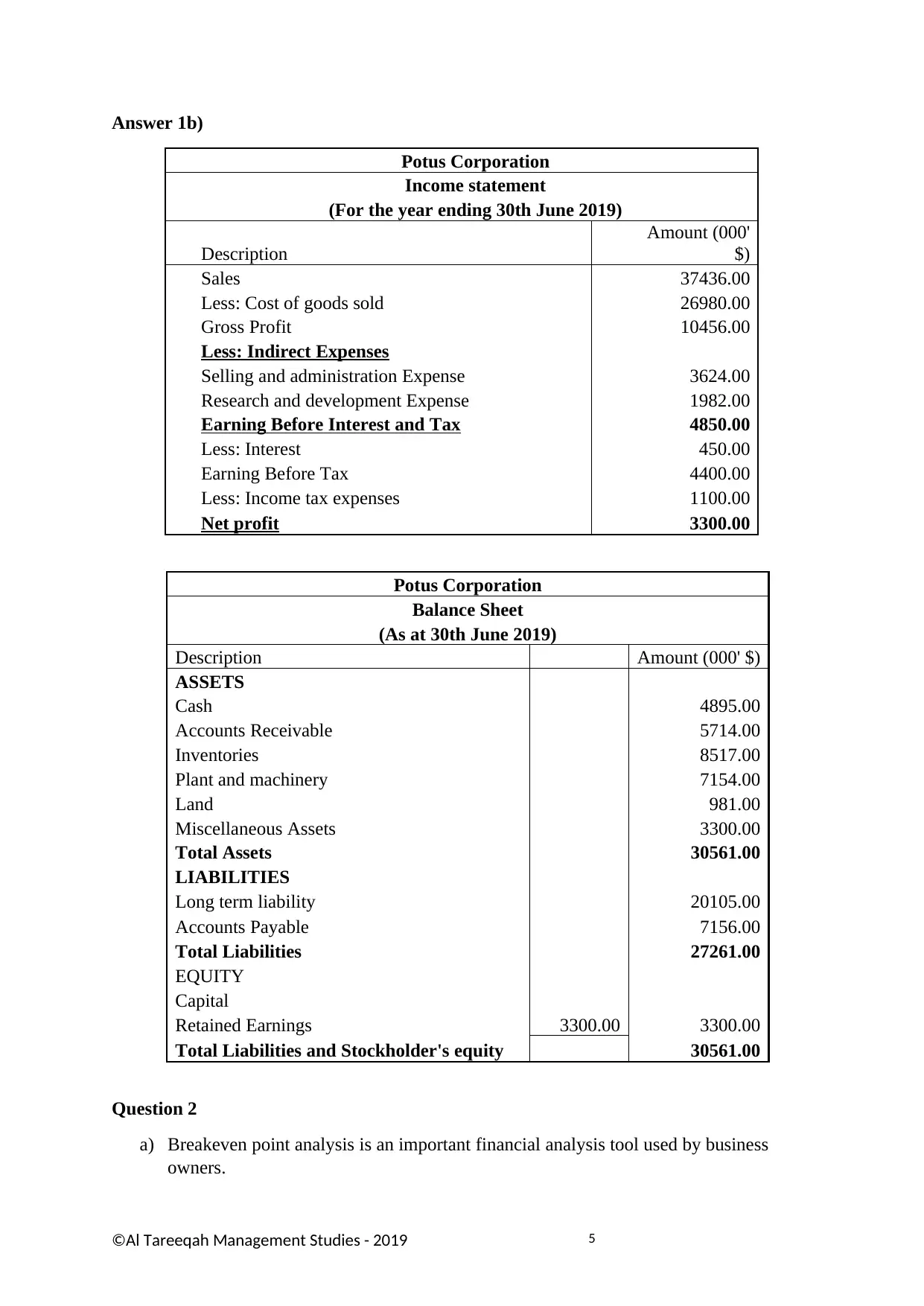
5
Answer 1b)
Potus Corporation
Income statement
(For the year ending 30th June 2019)
Description
Amount (000'
$)
Sales 37436.00
Less: Cost of goods sold 26980.00
Gross Profit 10456.00
Less: Indirect Expenses
Selling and administration Expense 3624.00
Research and development Expense 1982.00
Earning Before Interest and Tax 4850.00
Less: Interest 450.00
Earning Before Tax 4400.00
Less: Income tax expenses 1100.00
Net profit 3300.00
Potus Corporation
Balance Sheet
(As at 30th June 2019)
Description Amount (000' $)
ASSETS
Cash 4895.00
Accounts Receivable 5714.00
Inventories 8517.00
Plant and machinery 7154.00
Land 981.00
Miscellaneous Assets 3300.00
Total Assets 30561.00
LIABILITIES
Long term liability 20105.00
Accounts Payable 7156.00
Total Liabilities 27261.00
EQUITY
Capital
Retained Earnings 3300.00 3300.00
Total Liabilities and Stockholder's equity 30561.00
Question 2
a) Breakeven point analysis is an important financial analysis tool used by business
owners.
©Al Tareeqah Management Studies - 2019
Answer 1b)
Potus Corporation
Income statement
(For the year ending 30th June 2019)
Description
Amount (000'
$)
Sales 37436.00
Less: Cost of goods sold 26980.00
Gross Profit 10456.00
Less: Indirect Expenses
Selling and administration Expense 3624.00
Research and development Expense 1982.00
Earning Before Interest and Tax 4850.00
Less: Interest 450.00
Earning Before Tax 4400.00
Less: Income tax expenses 1100.00
Net profit 3300.00
Potus Corporation
Balance Sheet
(As at 30th June 2019)
Description Amount (000' $)
ASSETS
Cash 4895.00
Accounts Receivable 5714.00
Inventories 8517.00
Plant and machinery 7154.00
Land 981.00
Miscellaneous Assets 3300.00
Total Assets 30561.00
LIABILITIES
Long term liability 20105.00
Accounts Payable 7156.00
Total Liabilities 27261.00
EQUITY
Capital
Retained Earnings 3300.00 3300.00
Total Liabilities and Stockholder's equity 30561.00
Question 2
a) Breakeven point analysis is an important financial analysis tool used by business
owners.
©Al Tareeqah Management Studies - 2019
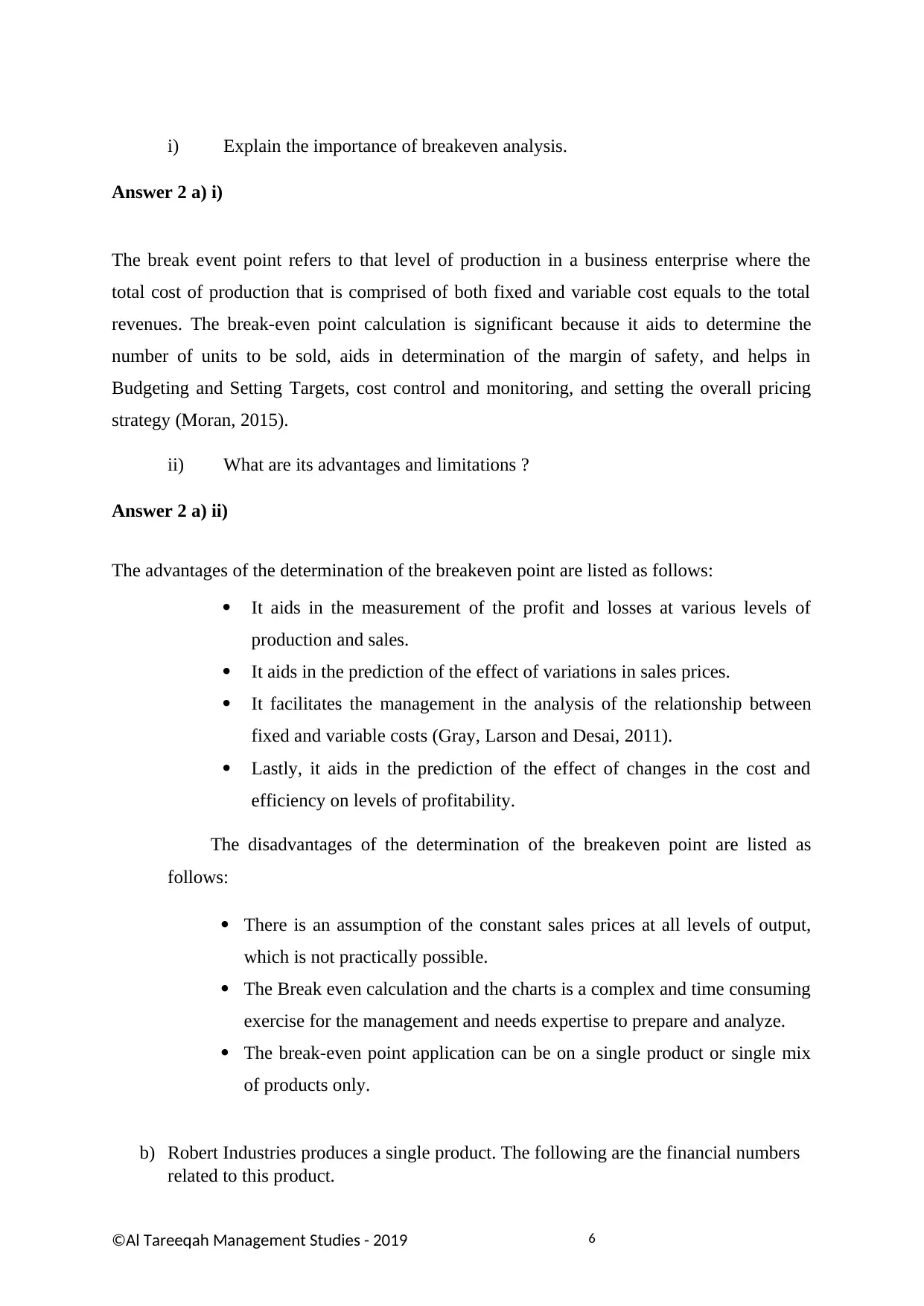
6
i) Explain the importance of breakeven analysis.
Answer 2 a) i)
The break event point refers to that level of production in a business enterprise where the
total cost of production that is comprised of both fixed and variable cost equals to the total
revenues. The break-even point calculation is significant because it aids to determine the
number of units to be sold, aids in determination of the margin of safety, and helps in
Budgeting and Setting Targets, cost control and monitoring, and setting the overall pricing
strategy (Moran, 2015).
ii) What are its advantages and limitations ?
Answer 2 a) ii)
The advantages of the determination of the breakeven point are listed as follows:
It aids in the measurement of the profit and losses at various levels of
production and sales.
It aids in the prediction of the effect of variations in sales prices.
It facilitates the management in the analysis of the relationship between
fixed and variable costs (Gray, Larson and Desai, 2011).
Lastly, it aids in the prediction of the effect of changes in the cost and
efficiency on levels of profitability.
The disadvantages of the determination of the breakeven point are listed as
follows:
There is an assumption of the constant sales prices at all levels of output,
which is not practically possible.
The Break even calculation and the charts is a complex and time consuming
exercise for the management and needs expertise to prepare and analyze.
The break-even point application can be on a single product or single mix
of products only.
b) Robert Industries produces a single product. The following are the financial numbers
related to this product.
©Al Tareeqah Management Studies - 2019
i) Explain the importance of breakeven analysis.
Answer 2 a) i)
The break event point refers to that level of production in a business enterprise where the
total cost of production that is comprised of both fixed and variable cost equals to the total
revenues. The break-even point calculation is significant because it aids to determine the
number of units to be sold, aids in determination of the margin of safety, and helps in
Budgeting and Setting Targets, cost control and monitoring, and setting the overall pricing
strategy (Moran, 2015).
ii) What are its advantages and limitations ?
Answer 2 a) ii)
The advantages of the determination of the breakeven point are listed as follows:
It aids in the measurement of the profit and losses at various levels of
production and sales.
It aids in the prediction of the effect of variations in sales prices.
It facilitates the management in the analysis of the relationship between
fixed and variable costs (Gray, Larson and Desai, 2011).
Lastly, it aids in the prediction of the effect of changes in the cost and
efficiency on levels of profitability.
The disadvantages of the determination of the breakeven point are listed as
follows:
There is an assumption of the constant sales prices at all levels of output,
which is not practically possible.
The Break even calculation and the charts is a complex and time consuming
exercise for the management and needs expertise to prepare and analyze.
The break-even point application can be on a single product or single mix
of products only.
b) Robert Industries produces a single product. The following are the financial numbers
related to this product.
©Al Tareeqah Management Studies - 2019
⊘ This is a preview!⊘
Do you want full access?
Subscribe today to unlock all pages.

Trusted by 1+ million students worldwide
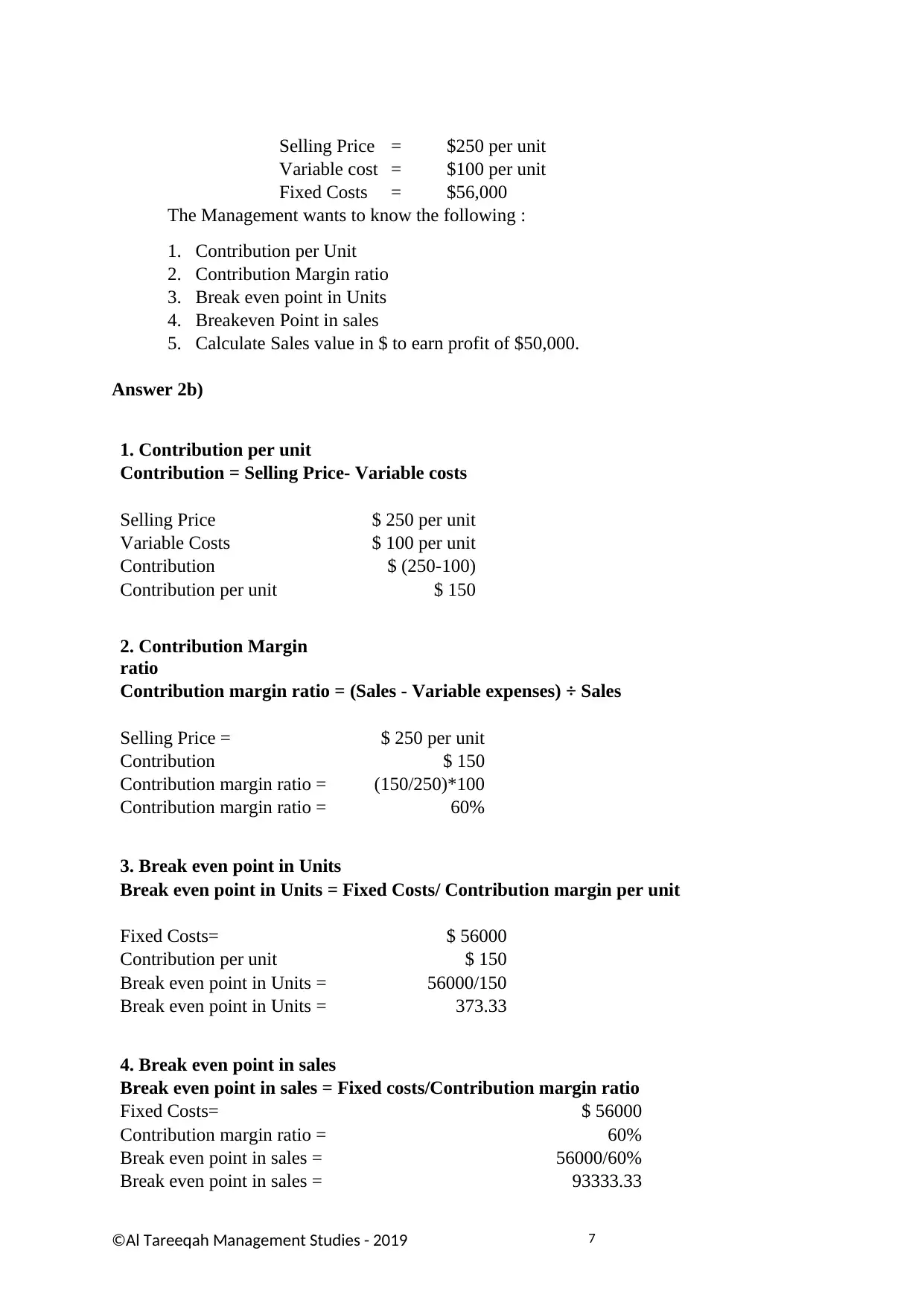
7
Selling Price = $250 per unit
Variable cost = $100 per unit
Fixed Costs = $56,000
The Management wants to know the following :
1. Contribution per Unit
2. Contribution Margin ratio
3. Break even point in Units
4. Breakeven Point in sales
5. Calculate Sales value in $ to earn profit of $50,000.
Answer 2b)
1. Contribution per unit
Contribution = Selling Price- Variable costs
Selling Price $ 250 per unit
Variable Costs $ 100 per unit
Contribution $ (250-100)
Contribution per unit $ 150
2. Contribution Margin
ratio
Contribution margin ratio = (Sales - Variable expenses) ÷ Sales
Selling Price = $ 250 per unit
Contribution $ 150
Contribution margin ratio = (150/250)*100
Contribution margin ratio = 60%
3. Break even point in Units
Break even point in Units = Fixed Costs/ Contribution margin per unit
Fixed Costs= $ 56000
Contribution per unit $ 150
Break even point in Units = 56000/150
Break even point in Units = 373.33
4. Break even point in sales
Break even point in sales = Fixed costs/Contribution margin ratio
Fixed Costs= $ 56000
Contribution margin ratio = 60%
Break even point in sales = 56000/60%
Break even point in sales = 93333.33
©Al Tareeqah Management Studies - 2019
Selling Price = $250 per unit
Variable cost = $100 per unit
Fixed Costs = $56,000
The Management wants to know the following :
1. Contribution per Unit
2. Contribution Margin ratio
3. Break even point in Units
4. Breakeven Point in sales
5. Calculate Sales value in $ to earn profit of $50,000.
Answer 2b)
1. Contribution per unit
Contribution = Selling Price- Variable costs
Selling Price $ 250 per unit
Variable Costs $ 100 per unit
Contribution $ (250-100)
Contribution per unit $ 150
2. Contribution Margin
ratio
Contribution margin ratio = (Sales - Variable expenses) ÷ Sales
Selling Price = $ 250 per unit
Contribution $ 150
Contribution margin ratio = (150/250)*100
Contribution margin ratio = 60%
3. Break even point in Units
Break even point in Units = Fixed Costs/ Contribution margin per unit
Fixed Costs= $ 56000
Contribution per unit $ 150
Break even point in Units = 56000/150
Break even point in Units = 373.33
4. Break even point in sales
Break even point in sales = Fixed costs/Contribution margin ratio
Fixed Costs= $ 56000
Contribution margin ratio = 60%
Break even point in sales = 56000/60%
Break even point in sales = 93333.33
©Al Tareeqah Management Studies - 2019
Paraphrase This Document
Need a fresh take? Get an instant paraphrase of this document with our AI Paraphraser
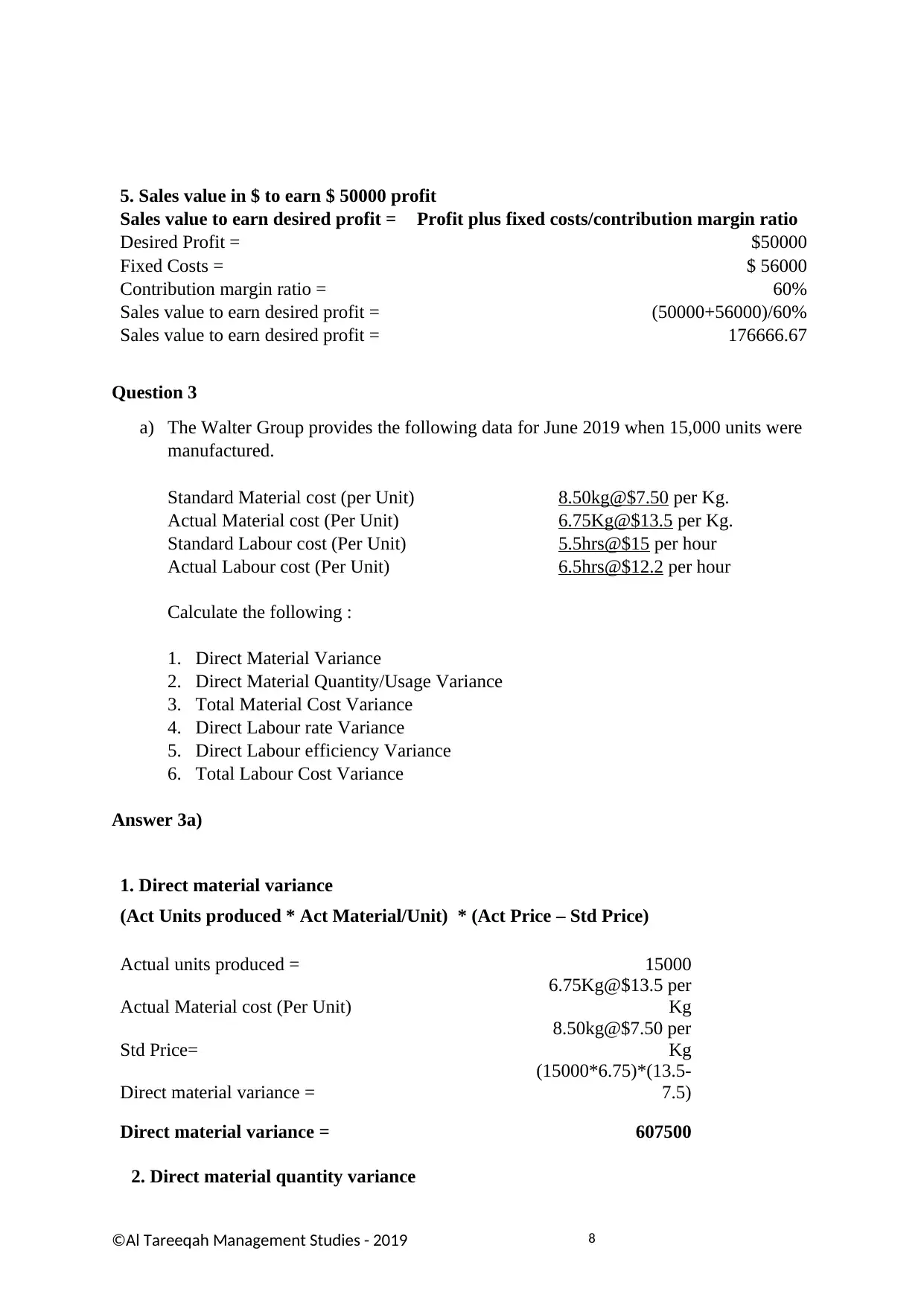
8
5. Sales value in $ to earn $ 50000 profit
Sales value to earn desired profit = Profit plus fixed costs/contribution margin ratio
Desired Profit = $50000
Fixed Costs = $ 56000
Contribution margin ratio = 60%
Sales value to earn desired profit = (50000+56000)/60%
Sales value to earn desired profit = 176666.67
Question 3
a) The Walter Group provides the following data for June 2019 when 15,000 units were
manufactured.
Standard Material cost (per Unit) 8.50kg@$7.50 per Kg.
Actual Material cost (Per Unit) 6.75Kg@$13.5 per Kg.
Standard Labour cost (Per Unit) 5.5hrs@$15 per hour
Actual Labour cost (Per Unit) 6.5hrs@$12.2 per hour
Calculate the following :
1. Direct Material Variance
2. Direct Material Quantity/Usage Variance
3. Total Material Cost Variance
4. Direct Labour rate Variance
5. Direct Labour efficiency Variance
6. Total Labour Cost Variance
Answer 3a)
1. Direct material variance
(Act Units produced * Act Material/Unit) * (Act Price – Std Price)
Actual units produced = 15000
Actual Material cost (Per Unit)
6.75Kg@$13.5 per
Kg
Std Price=
8.50kg@$7.50 per
Kg
Direct material variance =
(15000*6.75)*(13.5-
7.5)
Direct material variance = 607500
2. Direct material quantity variance
©Al Tareeqah Management Studies - 2019
5. Sales value in $ to earn $ 50000 profit
Sales value to earn desired profit = Profit plus fixed costs/contribution margin ratio
Desired Profit = $50000
Fixed Costs = $ 56000
Contribution margin ratio = 60%
Sales value to earn desired profit = (50000+56000)/60%
Sales value to earn desired profit = 176666.67
Question 3
a) The Walter Group provides the following data for June 2019 when 15,000 units were
manufactured.
Standard Material cost (per Unit) 8.50kg@$7.50 per Kg.
Actual Material cost (Per Unit) 6.75Kg@$13.5 per Kg.
Standard Labour cost (Per Unit) 5.5hrs@$15 per hour
Actual Labour cost (Per Unit) 6.5hrs@$12.2 per hour
Calculate the following :
1. Direct Material Variance
2. Direct Material Quantity/Usage Variance
3. Total Material Cost Variance
4. Direct Labour rate Variance
5. Direct Labour efficiency Variance
6. Total Labour Cost Variance
Answer 3a)
1. Direct material variance
(Act Units produced * Act Material/Unit) * (Act Price – Std Price)
Actual units produced = 15000
Actual Material cost (Per Unit)
6.75Kg@$13.5 per
Kg
Std Price=
8.50kg@$7.50 per
Kg
Direct material variance =
(15000*6.75)*(13.5-
7.5)
Direct material variance = 607500
2. Direct material quantity variance
©Al Tareeqah Management Studies - 2019
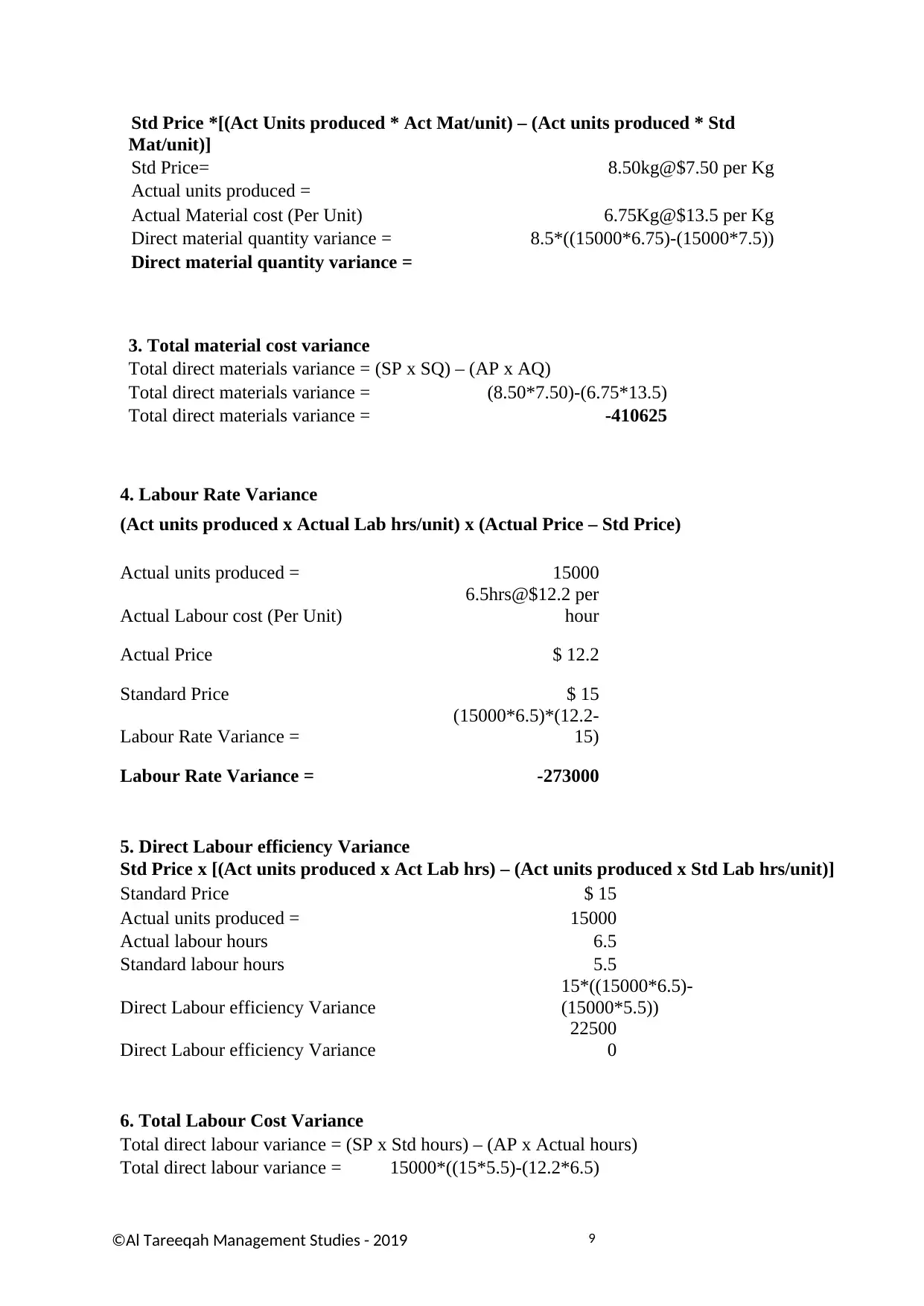
9
Std Price *[(Act Units produced * Act Mat/unit) – (Act units produced * Std
Mat/unit)]
Std Price= 8.50kg@$7.50 per Kg
Actual units produced =
Actual Material cost (Per Unit) 6.75Kg@$13.5 per Kg
Direct material quantity variance = 8.5*((15000*6.75)-(15000*7.5))
Direct material quantity variance =
3. Total material cost variance
Total direct materials variance = (SP x SQ) – (AP x AQ)
Total direct materials variance = (8.50*7.50)-(6.75*13.5)
Total direct materials variance = -410625
4. Labour Rate Variance
(Act units produced x Actual Lab hrs/unit) x (Actual Price – Std Price)
Actual units produced = 15000
Actual Labour cost (Per Unit)
6.5hrs@$12.2 per
hour
Actual Price $ 12.2
Standard Price $ 15
Labour Rate Variance =
(15000*6.5)*(12.2-
15)
Labour Rate Variance = -273000
5. Direct Labour efficiency Variance
Std Price x [(Act units produced x Act Lab hrs) – (Act units produced x Std Lab hrs/unit)]
Standard Price $ 15
Actual units produced = 15000
Actual labour hours 6.5
Standard labour hours 5.5
Direct Labour efficiency Variance
15*((15000*6.5)-
(15000*5.5))
Direct Labour efficiency Variance
22500
0
6. Total Labour Cost Variance
Total direct labour variance = (SP x Std hours) – (AP x Actual hours)
Total direct labour variance = 15000*((15*5.5)-(12.2*6.5)
©Al Tareeqah Management Studies - 2019
Std Price *[(Act Units produced * Act Mat/unit) – (Act units produced * Std
Mat/unit)]
Std Price= 8.50kg@$7.50 per Kg
Actual units produced =
Actual Material cost (Per Unit) 6.75Kg@$13.5 per Kg
Direct material quantity variance = 8.5*((15000*6.75)-(15000*7.5))
Direct material quantity variance =
3. Total material cost variance
Total direct materials variance = (SP x SQ) – (AP x AQ)
Total direct materials variance = (8.50*7.50)-(6.75*13.5)
Total direct materials variance = -410625
4. Labour Rate Variance
(Act units produced x Actual Lab hrs/unit) x (Actual Price – Std Price)
Actual units produced = 15000
Actual Labour cost (Per Unit)
6.5hrs@$12.2 per
hour
Actual Price $ 12.2
Standard Price $ 15
Labour Rate Variance =
(15000*6.5)*(12.2-
15)
Labour Rate Variance = -273000
5. Direct Labour efficiency Variance
Std Price x [(Act units produced x Act Lab hrs) – (Act units produced x Std Lab hrs/unit)]
Standard Price $ 15
Actual units produced = 15000
Actual labour hours 6.5
Standard labour hours 5.5
Direct Labour efficiency Variance
15*((15000*6.5)-
(15000*5.5))
Direct Labour efficiency Variance
22500
0
6. Total Labour Cost Variance
Total direct labour variance = (SP x Std hours) – (AP x Actual hours)
Total direct labour variance = 15000*((15*5.5)-(12.2*6.5)
©Al Tareeqah Management Studies - 2019
⊘ This is a preview!⊘
Do you want full access?
Subscribe today to unlock all pages.

Trusted by 1+ million students worldwide

10
Total direct labour variance = 48000
b) Calculate variable overhead spending variance if actual labour hours used are 260,
standard variable overhead rate is $10.40 per direct labour hour and actual variable
overhead rate is $9.30 per direct labor hour. Also specify whether the variance is
favourable or unfavourable.
Answer 3b)
Overhead spending variance
Labour hours used = 260
Standard rate =
10.
4
Actual rate = 9.3
Overhead spending variance 260*(10.4-9.3)
Overhead spending variance 286
Favourable Variance
c) Define the term Variance Analysis and highlight its Advantages and Disadvantages.
Answer 3) c)
Variance analysis deals with the assessment of the variations from the planned and actual
performance, and the review of the fields concerned. Thus, the key drivers of the variations in
the planned and actual budgets are analysed and suitable measures are devised to mitigate
such deviations in future.
The advantages of variance analysis are that the same aids the management in the efficient
and detailed managerial decisions, the tools works as a control measure for the spending
within an enterprise, and also aids in the assignment of responsibility and engaging
department wise responsibilities. The limitations are that the same is dependent on the
efficiency of the budgeting process, and if the former is not done efficiently, there is no
significance of the variance analysis.
Question 4
a) Underline the main components which are considered while preparing a budget in a
©Al Tareeqah Management Studies - 2019
Total direct labour variance = 48000
b) Calculate variable overhead spending variance if actual labour hours used are 260,
standard variable overhead rate is $10.40 per direct labour hour and actual variable
overhead rate is $9.30 per direct labor hour. Also specify whether the variance is
favourable or unfavourable.
Answer 3b)
Overhead spending variance
Labour hours used = 260
Standard rate =
10.
4
Actual rate = 9.3
Overhead spending variance 260*(10.4-9.3)
Overhead spending variance 286
Favourable Variance
c) Define the term Variance Analysis and highlight its Advantages and Disadvantages.
Answer 3) c)
Variance analysis deals with the assessment of the variations from the planned and actual
performance, and the review of the fields concerned. Thus, the key drivers of the variations in
the planned and actual budgets are analysed and suitable measures are devised to mitigate
such deviations in future.
The advantages of variance analysis are that the same aids the management in the efficient
and detailed managerial decisions, the tools works as a control measure for the spending
within an enterprise, and also aids in the assignment of responsibility and engaging
department wise responsibilities. The limitations are that the same is dependent on the
efficiency of the budgeting process, and if the former is not done efficiently, there is no
significance of the variance analysis.
Question 4
a) Underline the main components which are considered while preparing a budget in a
©Al Tareeqah Management Studies - 2019
Paraphrase This Document
Need a fresh take? Get an instant paraphrase of this document with our AI Paraphraser

11
Company. What are the major considerations business owners should make as they
budget and forecast ?
Answer 4) a)
The main components that are considered by the management during a preparation of a
budget of a company are the expenses, overhead costs, aggregates, and income. These above
listed components are essential to determine the future course of earnings and spending of an
entity. Some of the major considerations to be taken to prepare a budget in an organisation
are listed as follows. It is important for the management to review the short term and the long
term goals of an entity and to understand the sources of the revenues that is whether the same
are temporary or consistent (Ross, Westerfield, Jaffe and Kakani, 2014). The various stakeholder
interests must be considered to determine the objective of budget that is to distribute earnings
or save for an expansion. Further, the estimates must be made regarding the economic
condition, competitor influence on sales, and other relevant market research.
b) Prepare a Cash budget for the Quarter April To June based on the following data and
additional information.
Month Sales($) Purchase($) Wages($) Overheads($)
Jan 60,000 36,000 9,000 10,000
Feb 62,000 38,000 8,000 9,500
Mar 64,000 33,000 10,000 11,500
Apr 58,000 35,000 8,500 9,000
May 56,000 39,000 9,000 9,500
Jun 60,000 34,000 8,000 9,000
Additional Information :
1. Cash balance at 1st April is $800,000
2. Sales is 40% cash sales and 60% is collected in the following month.
3. All purchases of a month are paid after 2 months.
4. Land was purchased in April for $85,000
5. Wages of a month are paid the following month. All overheads are paid the same
month.
6. Loan repaid in May $16,000
7. Dividend of $75,000 is expected to be received in May.
©Al Tareeqah Management Studies - 2019
Company. What are the major considerations business owners should make as they
budget and forecast ?
Answer 4) a)
The main components that are considered by the management during a preparation of a
budget of a company are the expenses, overhead costs, aggregates, and income. These above
listed components are essential to determine the future course of earnings and spending of an
entity. Some of the major considerations to be taken to prepare a budget in an organisation
are listed as follows. It is important for the management to review the short term and the long
term goals of an entity and to understand the sources of the revenues that is whether the same
are temporary or consistent (Ross, Westerfield, Jaffe and Kakani, 2014). The various stakeholder
interests must be considered to determine the objective of budget that is to distribute earnings
or save for an expansion. Further, the estimates must be made regarding the economic
condition, competitor influence on sales, and other relevant market research.
b) Prepare a Cash budget for the Quarter April To June based on the following data and
additional information.
Month Sales($) Purchase($) Wages($) Overheads($)
Jan 60,000 36,000 9,000 10,000
Feb 62,000 38,000 8,000 9,500
Mar 64,000 33,000 10,000 11,500
Apr 58,000 35,000 8,500 9,000
May 56,000 39,000 9,000 9,500
Jun 60,000 34,000 8,000 9,000
Additional Information :
1. Cash balance at 1st April is $800,000
2. Sales is 40% cash sales and 60% is collected in the following month.
3. All purchases of a month are paid after 2 months.
4. Land was purchased in April for $85,000
5. Wages of a month are paid the following month. All overheads are paid the same
month.
6. Loan repaid in May $16,000
7. Dividend of $75,000 is expected to be received in May.
©Al Tareeqah Management Studies - 2019
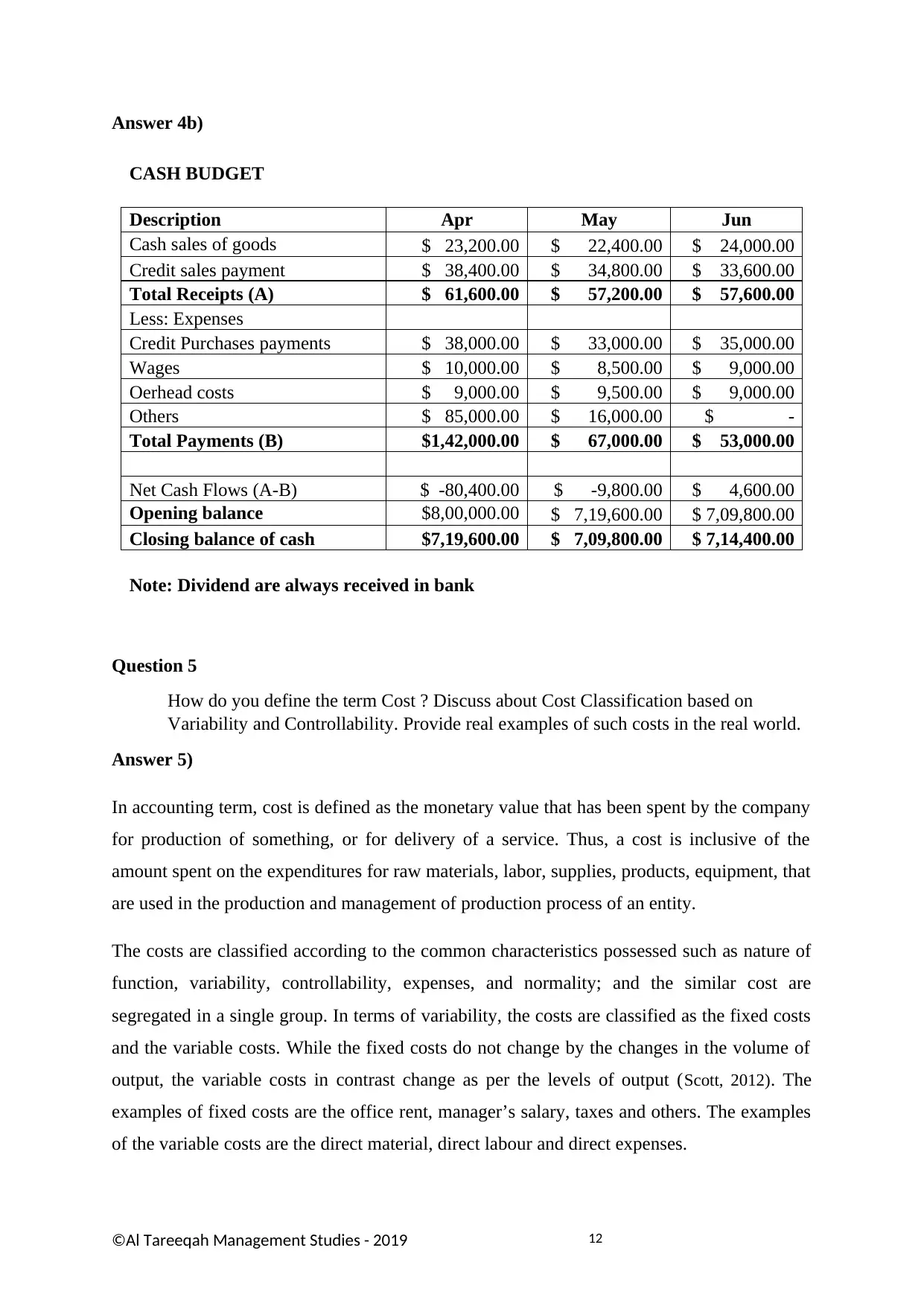
12
Answer 4b)
CASH BUDGET
Description Apr May Jun
Cash sales of goods $ 23,200.00 $ 22,400.00 $ 24,000.00
Credit sales payment $ 38,400.00 $ 34,800.00 $ 33,600.00
Total Receipts (A) $ 61,600.00 $ 57,200.00 $ 57,600.00
Less: Expenses
Credit Purchases payments $ 38,000.00 $ 33,000.00 $ 35,000.00
Wages $ 10,000.00 $ 8,500.00 $ 9,000.00
Oerhead costs $ 9,000.00 $ 9,500.00 $ 9,000.00
Others $ 85,000.00 $ 16,000.00 $ -
Total Payments (B) $1,42,000.00 $ 67,000.00 $ 53,000.00
Net Cash Flows (A-B) $ -80,400.00 $ -9,800.00 $ 4,600.00
Opening balance $8,00,000.00 $ 7,19,600.00 $ 7,09,800.00
Closing balance of cash $7,19,600.00 $ 7,09,800.00 $ 7,14,400.00
Note: Dividend are always received in bank
Question 5
How do you define the term Cost ? Discuss about Cost Classification based on
Variability and Controllability. Provide real examples of such costs in the real world.
Answer 5)
In accounting term, cost is defined as the monetary value that has been spent by the company
for production of something, or for delivery of a service. Thus, a cost is inclusive of the
amount spent on the expenditures for raw materials, labor, supplies, products, equipment, that
are used in the production and management of production process of an entity.
The costs are classified according to the common characteristics possessed such as nature of
function, variability, controllability, expenses, and normality; and the similar cost are
segregated in a single group. In terms of variability, the costs are classified as the fixed costs
and the variable costs. While the fixed costs do not change by the changes in the volume of
output, the variable costs in contrast change as per the levels of output (Scott, 2012). The
examples of fixed costs are the office rent, manager’s salary, taxes and others. The examples
of the variable costs are the direct material, direct labour and direct expenses.
©Al Tareeqah Management Studies - 2019
Answer 4b)
CASH BUDGET
Description Apr May Jun
Cash sales of goods $ 23,200.00 $ 22,400.00 $ 24,000.00
Credit sales payment $ 38,400.00 $ 34,800.00 $ 33,600.00
Total Receipts (A) $ 61,600.00 $ 57,200.00 $ 57,600.00
Less: Expenses
Credit Purchases payments $ 38,000.00 $ 33,000.00 $ 35,000.00
Wages $ 10,000.00 $ 8,500.00 $ 9,000.00
Oerhead costs $ 9,000.00 $ 9,500.00 $ 9,000.00
Others $ 85,000.00 $ 16,000.00 $ -
Total Payments (B) $1,42,000.00 $ 67,000.00 $ 53,000.00
Net Cash Flows (A-B) $ -80,400.00 $ -9,800.00 $ 4,600.00
Opening balance $8,00,000.00 $ 7,19,600.00 $ 7,09,800.00
Closing balance of cash $7,19,600.00 $ 7,09,800.00 $ 7,14,400.00
Note: Dividend are always received in bank
Question 5
How do you define the term Cost ? Discuss about Cost Classification based on
Variability and Controllability. Provide real examples of such costs in the real world.
Answer 5)
In accounting term, cost is defined as the monetary value that has been spent by the company
for production of something, or for delivery of a service. Thus, a cost is inclusive of the
amount spent on the expenditures for raw materials, labor, supplies, products, equipment, that
are used in the production and management of production process of an entity.
The costs are classified according to the common characteristics possessed such as nature of
function, variability, controllability, expenses, and normality; and the similar cost are
segregated in a single group. In terms of variability, the costs are classified as the fixed costs
and the variable costs. While the fixed costs do not change by the changes in the volume of
output, the variable costs in contrast change as per the levels of output (Scott, 2012). The
examples of fixed costs are the office rent, manager’s salary, taxes and others. The examples
of the variable costs are the direct material, direct labour and direct expenses.
©Al Tareeqah Management Studies - 2019
⊘ This is a preview!⊘
Do you want full access?
Subscribe today to unlock all pages.

Trusted by 1+ million students worldwide
1 out of 15
Related Documents
Your All-in-One AI-Powered Toolkit for Academic Success.
+13062052269
info@desklib.com
Available 24*7 on WhatsApp / Email
![[object Object]](/_next/static/media/star-bottom.7253800d.svg)
Unlock your academic potential
Copyright © 2020–2025 A2Z Services. All Rights Reserved. Developed and managed by ZUCOL.





